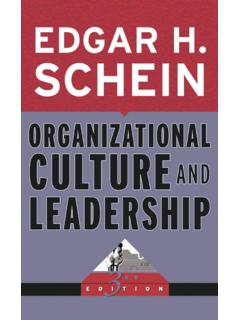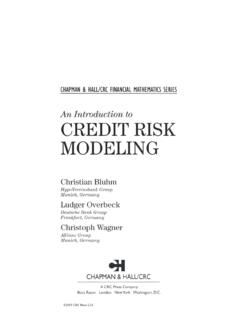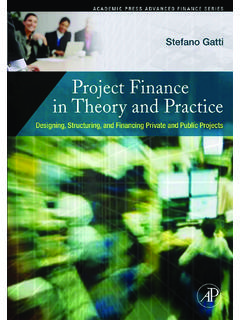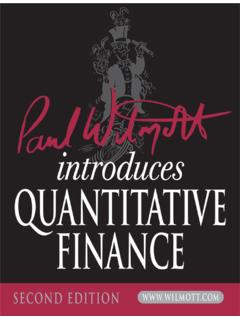Transcription of Selected material from - UNTAG
1 Selected material fromFundamentals of Corporate FinanceThird EditionRichard A. BrealeyBank of England and London Business SchoolStewart C. MyersSloan School of ManagementMassachusetts Institute of TechnologyAlan J. MarcusWallace E. Carroll School of ManagementBoston Collegewith additional material fromFundamentals of Corporate Finance,Alternate Fifth EditionEssentials of Corporate Finance, Second EditionStephen A. Ross,Massachusetts Institute of TechnologyRandolph W. Westerfield,University of Southern CaliforniaBradford D. Jordan, University of KentuckyUNIVERSITY OF PHOENIXB oston Burr Ridge, IL Dubuque, IA Madison, WI New York San Francisco St. LouisBangkok Bogot Caracas Lisbon London MadridMexico City Milan New Delhi Seoul Singapore Sydney Taipei TorontoSelected material fromFUNDAMENTALS OF CORPORATE FINANCE, Third Editionwith additional material fromFUNDAMENTALS OF CORPORATE FINANCE, Alternate Fifth EditionESSENTIALS OF CORPORATE FINANCE, Second EditionCopyright 2001 by The McGraw-Hill Companies, Inc.
2 All rights reserved. Printed in the United States of America. Ex-cept as permitted under the United States Copyright Act of 1976, no part of this publication may be reproduced or distrib-uted in any form or by any means, or stored in a data base retrieval system, without prior written permission of the book contains select material from:Fundamentals of Corporate Finance, Third Edition by Richard A. Brealey, Stewart C. Myers, and Alan J. Marcus. Copyright 2001, 1999, 1995, by The McGraw-Hill Companies, of Corporate Finance, Alternate Fifth Edition by Stephen A. Ross, Randolph W. Westerfield, and Bradford Copyright 2000, 1998, 1995, 1993, 1991 by The McGraw-Hill Companies, of Corporate Finance, Second Edition by Stephen A. Ross, Randolph W. Westerfield, and Bradford D.
3 1999 by The McGraw-Hill Companies, Inc. Previous edition 1996 by Richard D. Irwin, a Times MirrorHigher Education Group, Inc. reprinted with permission of the 0-07-553109-7 Sponsoring Editor: Christian PerleeProduction Editor: Nina Meyer iiiContentsSECTION 11 How to Value Perpetuities 50 How to Value Annuities 51 Annuities Due 54 Future Value of an Annuity 57 Inflation and the Time Value of Money 61 Real versus Nominal Cash Flows 61 Inflation and Interest Rates 63 Valuing Real Cash Payments 65 Real or Nominal? 67 Effective Annual Interest Rates 67 Summary 69 Related Web Links 69 Key Terms 70 Quiz 70 Practice Problems 72 Challenge Problems 75 Solutions to Self-Test Questions 77 Minicase 79 Financial Planning 81 What Is Financial Planning?
4 82 Financial Planning Focuses on the Big Picture 83 Financial Planning Is Not Just Forecasting 84 Three Requirements for Effective Planning 84 Financial Planning Models 86 Components of a Financial Planning Model 87An Example of a Planning Model 88An Improved Model 89 Planners Beware 93 Pitfalls in Model Design 93 The Assumption in Percentage of Sales Models 94 The Role of Financial Planning Models 95 External Financing and Growth 96 Summary 100 Related Web Links 101 Key Terms 101 Quiz 101 Practice Problems 102 Challenge Problems 106 Solutions to Self-Test Questions 106 The Firm and the Financial Manager 3 Organizing a Business4 Sole Proprietorships 4 Partnerships 5 Corporations 5 Hybrid Forms of Business Organization 6 The Role of the Financial Manager 7 The Capital Budgeting Decision 8 The Financing Decision 9 Financial Institutions and Markets 10 Financial Institutions 10 Financial Markets 11 Other Functions of Financial Markets and Institutions 12 Who Is the Financial Manager?
5 13 Careers in Finance 15 Goals of the Corporation 17 Shareholders Want Managers to Maximize Market Value 17 Ethics and Management Objectives 19Do Managers Really Maximize Firm Value? 21 Snippets of History 25 Summary 25 Related Web Links28 Key Terms 28 Quiz28 Practice Problems29 Solutions to Self-Test Questions 31 The Time Value of Money 33 Future Values and Compound Interest 34 Present Values 38 Finding the Interest Rate 44 Multiple Cash Flows 46 Future Value of Multiple Cash Flows 46 Present Value of Multiple Cash Flows 49 Level Cash Flows: Perpetuities and Annuities 50 Financial Statement Analysis 133 Financial Ratios 134 Leverage Ratios 138 Liquidity Ratios 139 Efficiency Ratios 141 Profitability Ratios 143 The Du Pont System 145 Other Financial Ratios 146 Using Financial Ratios 147 Choosing a Benchmark 147 Measuring Company Performance 150 The Role of Financial Ratios 151 Summary 153 Related Web Links 155 Key Terms 155 Quiz 155 Practice Problems 157 Challenge Problem 158 Solutions to Self-Test Questions 159 Minicase 160 IVCONTENTSA ccounting and Finance 111 The Balance Sheet 112 Book Values and Market Values 115 The Income Statement 117 Profits versus Cash Flow 118 The Statement of Cash Flows 119 Accounting for Differences
6 121 Taxes 123 Corporate Tax 123 Personal Tax 125 Summary 126 Related Web Links 127 Key Terms 127 Quiz 127 Practice Problems 128 Challenge Problem 131 Solutions to Self-Test Questions 131 APPENDIX A109 section 2163 Working Capital Management and Short-Term Planning 165 Working Capital 167 The Components of Working Capital 167 Working Capital and the Cash Conversion Cycle 168 The Working Capital Trade-Off 171 Links between Long-Term and Short-TermFinancing 172 Tracing Changes in Cash and Working Capital 175 Cash Budgeting 177 Forecast Sources of Cash 177 Forecast Uses of Cash 179 The Cash Balance 179A Short-Term Financing Plan 180 Options for Short-Term Financing 180 Evaluating the Plan 184 Sources of Short-Term Financing 185 Bank Loans 185 Commercial Paper 186 Secured Loans 186 The Cost of Bank Loans 187 Simple Interest 187 Discount Interest 188 Interest with Compensating Balances 189 Summary 190 Related Web Links 191 Key Terms 191 Quiz 191 Practice Problems 192 Challenge Problem 194 Solutions to Self-Test Questions 195 Minicase 197 Cash and Inventory Management 201 Cash Collection, Disbursement.
7 And Float 202 Float 203 Valuing Float 204 CONTENTSVM anaging Float 205 Speeding Up Collections 206 Controlling Disbursements209 Electronic Funds Transfer 210 Inventories and Cash Balances 211 Managing Inventories 212 Managing Inventories of Cash 215 Uncertain Cash Flows 216 Cash Management in the Largest Corporations 217 Investing Idle Cash: The Money Market 218 Summary 219 Related Web Links 220 Key Terms 220 Quiz 220 Practice Problems 221 Challenge Problem 224 Solutions to Self-Test Questions 224 Credit Management and Collection 227 Terms of Sale 229 Credit Agreements 231 Credit Analysis 232 Financial Ratio Analysis 233 Numerical Credit Scoring 233 When to Stop Looking for Clues 234 The Credit Decision 236 Credit Decisions with Repeat Orders237 Some General Principles238 Collection Policy 239 Bankruptcy 240 Bankruptcy Procedures241 The Choice between Liquidation and Reorganization242 Summary 244 Related Web Links245 Key Terms245 Quiz245 Practice Problems246 Challenge Problems248 Solutions to Self-Test Questions249 Minicase 250 Valuing Bonds 255
8 Bond Characteristics 256 Reading the Financial Pages 257 Bond Prices and Yields259 How Bond Prices Vary with Interest Rates 260 Yield to Maturity versus Current Yield 261 Rate of Return 265 Interest Rate Risk 267 The Yield Curve 268 Nominal and Real Rates of Interest 268 Default Risk 270 Valuations in Corporate Bonds 273 Summary273 Related Web Links 274 Key Terms 274 Quiz 274 Practice Problems 275 Challenge Problems 277 Solutions to Self-Test Questions 277 Valuing Stocks 279 Stocks and the Stock Market 280 Reading the Stock Market Listings 281 Book Values, Liquidation Values, and MarketValues 283 Valuing Common Stocks 287 Today s Price and Tomorrow s Price 287 The Dividend Discount Model 288 Simplifying the Dividend Discount Model 291 The Dividend Discount Model with No Growth 291 The Constant-Growth Dividend Discount Model 292 Estimating Expected Rates of Return 293 Nonconstant Growth 295 Growth Stocks and Income Stocks 296 The Price-Earnings Ratio 298 What Do Earnings Mean?
9 298 Valuing Entire Businesses 301 Summary 301 Related Web Links 302 Key Terms 302 Quiz 302 Practice Problems 303 Challenge Problems 306 Solutions to Self-Test Questions 307 section 3253 VICONTENTSI ntroduction to Risk, Return, and theOpportunity Cost of Capital 311 Rates of Return: A Review 312 Seventy-Three Years of Capital Market History 313 Market Indexes 314 The Historical Record 314 Using Historical Evidence to Estimate Today s Cost ofCapital 317 Measuring Risk 318 Variance and Standard Deviation 318A Note on Calculating Variance 322 Measuring the Variation in Stock Returns 322 Risk and Diversification 324 Diversification 324 Asset versus Portfolio Risk 325 Market Risk versus Unique Risk 330 Thinking about Risk 331 Message 1: Some Risks Look Big and Dangerous butReally Are Diversifiable 331 Message 2: Market Risks Are Macro Risks 332 Message 3.
10 Risk Can Be Measured 333 Summary 334 Related Web Links 334 Key Terms 334 Quiz 335 Practice Problems 336 Solutions to Self-Test Questions 338 section 4339 Net Present Value and Other InvestmentCriteria 341 Net Present Value 343A Comment on Risk and Present Value 344 Valuing Long-Lived Projects 345 Other Investment Criteria 349 Internal Rate of Return 349A Closer Look at the Rate of Return Rule 350 Calculating the Rate of Return for Long-Lived Projects 351A Word of Caution 352 Payback 352 Book Rate of Return 355 Investment Criteria When Projects Interact 356 Mutually Exclusive Projects 356 Investment Timing 357 Long- versus Short-Lived Equipment 359 Replacing an Old Machine 361 Mutually Exclusive Projects and the IRR Rule 361 Other Pitfalls of the IRR Rule 363 Capital Rationing 365 Soft Rationing 365 Hard Rationing 366 Pitfalls of the Profitability Index 3667 Summary 367 Related Web Links 368 Key Terms 368 Quiz 368 Practice Problems 369 Challenge Problems 373 Solutions to Self-Test Questions 373 Using Discounted Cash-Flow Analysis toMake Investment Decisions 377 Discount Cash Flows.









